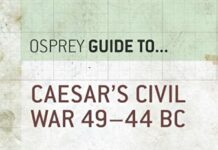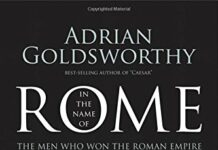
Ebook Info
- Published: 2011
- Number of pages: 224 pages
- Format: PDF
- File Size: 171.18 MB
- Authors: Adrian Goldsworthy
Description
“An outstanding general study of the Roman military system. . . . The best one-volume treatment of the subject now in existence.”―Historian The Roman army was one of the most successful fighting forces in history. Its organization and tactics were highly advanced and were unequaled until the modern era. Spectacular monuments to its perseverance and engineering skill are still visible today, most notably Hadrian’s Wall and the siegeworks around the fortress of Masada. This book is the first to examine in detail not just the early imperial army but also the citizens’ militia of the Republic and the army of the later Empire. The unprecedented scope and longevity of Roman military success is placed in the context of ordinary soldiers’ daily lives, whether spent in the quiet routine of a peaceful garrison or in arduous campaign and violent combat. Key battles and tactics are described, and there are brief biographies of the great commanders. Drawing on archaeology, ancient art, and original documentary sources, this book presents the most convincing history ever published of the Roman army. 107 full-color and 147 black-and-white illustrations
User’s Reviews
Editorial Reviews: Review “If you or someone you love has an interest in Rome, ancient history, or military history, this would make an excellent gift come Christmas.” ― Portland Book Review About the Author Adrian Goldsworthy is an English historian whose publications include The Roman Army at War: 100 BC-AD 200, The Complete Roman Army, Roman Warfare, The Punic Wars, and Cannae.
Reviews from Amazon users which were colected at the time this book was published on the website:
⭐My first impression on receiving this book was that at 214 pages it was far too short to be considered a “complete” history of the Roman Army. However, Dr. Adrian Goldsworthy is one of the finest Roman-era historians writing today and he packs a considerable amount of detail into this slim volume. Although the volume is primarily a synthesis of other existing works, Goldsworthy has taken the best materials – including recent archaeological research from Kalkriese in Germany – to provide a very balanced portrait of this subject. Furthermore, The Complete Roman Army has a very high graphic quality, with beautiful color photographs of uniforms, reconstructed and ruined fortifications, weapons and locations. Indeed, this book is easily the best one-volume work available on the Roman Army today. The Complete Roman Army consists of five major sections: the Republican Army (25 pages), the professional army (29 pages), the life of a Roman soldier (87 pages), the army at war (35 pages) and the army of late antiquity (14 pages). Goldsworthy covers numerous topics, including recruitment, daily routines, rewards and punishments, religion, retirement, equipment, rank structure and off-duty behavior. In essence, this represents a “handbook” on the Roman army. The author also includes order of battle data on the Roman Army, maps of garrison locations, layouts of camps and sidebars on major battles like Pharsalus and the defeat of Boudicca. Although some readers might wish greater detail than Goldsworthy can provide on some subjects, the author’s extensive bibliography does point to other sources for expanded information. All in all, Goldsworthy’s synthesis and condensation of so much information into such a small space is impressive. Goldsworthy’s discussion of Roman battle tactics follows in the tracks of his earlier works on the subject and I do find some gaps in his otherwise superb analysis. Goldsworthy never really explains how the Romans were so often victorious in the close battle; in previous books, Goldsworthy suggested that it was a handful of “extra-aggressive” soldiers who “broke into the enemy line” but in this book he leaves it more vague. While Goldsworthy notes the importance of the reserve in a Roman army, he doesn’t discuss how it was used to win battles. Furthermore, he uses literary evidence from Caesar’s commentaries to suggest that Roman soldiers charged at their enemies, hurling their pilum at 10-15 meters and then crashed into their line. The idea that a soldier could run with armor and scutum, throw a javelin, then draw his sword while maintaining linear order with the soldiers on his right and left in the space of perhaps 6-10 seconds is absurd. Indeed, the idea of running with a large rectangular shield like the scutum seems pretty absurd. Given the Roman emphasis on tight discipline and the need to use the shields to cover the front rank, I think it far more like that Roman infantry advanced methodically. In the final section, Goldsworthy spends little effort discussing the role of the army in Rome’s decline and fall. While the author does mention the army’s role in causing political instability in the empire and the difficulty its smaller units had in defeating Barbarian invasions, he dismisses the “Barbarization” theory and delves no further into examining the decline. Yet it is clear from the sources and evidence we have available that the Roman Army did decline in quality toward the end and that it was up against tougher opposition (Goldsworthy never mentions the Goths, Ostrogoths, Vandals or Huns). The Roman military system was based on a high level of tactical organization, skill and discipline – all of which apparently declined over time and contributed to their eventual defeat.
⭐This is a wonderfully researched, written and assembled reference book covering various aspects of the Roman Army over several centuries. The author did a careful and scholarly job of putting together and referencing important historical information which provides substance and accuracy. It is full of beautful photographs and illustrations that are of great benefit to understanding.Everyone interested in the Roman Army must own and read this book.However, I am still looking for something more…maybe a bit different……. which takes nothing away from the brilliance of this book.As a challenge to authors, the one subject that intrigues me after reading so many books on Roman history, has to do with the soldiers who made up the legions, in particular the soldiers who served during the time of Julius Caesar when there were no permanent garrisons..when daily life for 16 years consisted of hand to hand combat with sword and pilum or travelling great distances by foot and life was in a tent. i.e. what sort of people were these? What were the centurion like to organize, lead and motivate these troops ? How exactly did they win in combat ? How did troop formations change so quickly during battle …we know that they did but exactly how was this possible given the nature of the combat at hand? Many battles lasted for many hours, some for days, where initial formations could not have been sustained…what happened then? In such difficult and lengthy battles was it a role of the reserve to reestablish the formation or did centurions take over with success dependent upon individual initiatives at the “squad, platoon and company” level as is taught in the American Army today.and how did the personal charisma of the great Roman leaders such as Julius and Germanicus personally affect these troops? Clearly the famous disasters of the Roman Army are linked to disastrous and less famous leaders. But to me the real mystery of the Roman Army is how the elements of military leadership, discipline, motivation and technology all somehow came together to produce results, both good and bad, across the span of Republic and Empire with my special interest in Julius Caesar who must have been one of the most remarkable and effective military leaders in all of human history. In repeated examples his mere presence changed the behavior of thousands of troops….what kind of man was this ? How did such leaders view themselves and how did they view others ?(By the way, Goldsworthy takes on the subject of Julius Caesar in another wonderful book that he wrote “Caesar” which I also highly recommend.)So I am still looking not for the chronology or facts of history but rather more about the people who actually produced the results that we read about.
⭐seems to be pretty thorough. Most pictures in black and white.
⭐A very informative book with great accompanying diagrams and pictures of the Republican and Imperial armies. It follows the development of the Roman army from a peoples militia, made up of elite-citizen farmers, through to a professional unit made up of essentially the poorer elements of society after the Marian reforms. It also dissects the legions and their auxiliary troops into their smaller units, explaining the size, armament and functions of these in what could be termed as the first professional paid army in history. It also includes descriptions of key battles and sieges with their corresponding diagrams.
⭐Great introduction to the subject by a top expert. I read this in conjunction with his ‘Vindolanda’ historical novels, which show the Roman army in barracks and in action.
⭐Loved this book it gave.me a great insight into the roman army so I could help my grandkids with the school work + more knowledge for my self.
⭐I purchased a few books about Romans. Could have saved money by just buying this one
⭐Excellent book with a mass of detail and very good illustrations through out. Highly recommended for all enthusiasts of The Roman Empire.
Keywords
Free Download Complete Roman Army (The Complete Series) in PDF format
Complete Roman Army (The Complete Series) PDF Free Download
Download Complete Roman Army (The Complete Series) 2011 PDF Free
Complete Roman Army (The Complete Series) 2011 PDF Free Download
Download Complete Roman Army (The Complete Series) PDF
Free Download Ebook Complete Roman Army (The Complete Series)

